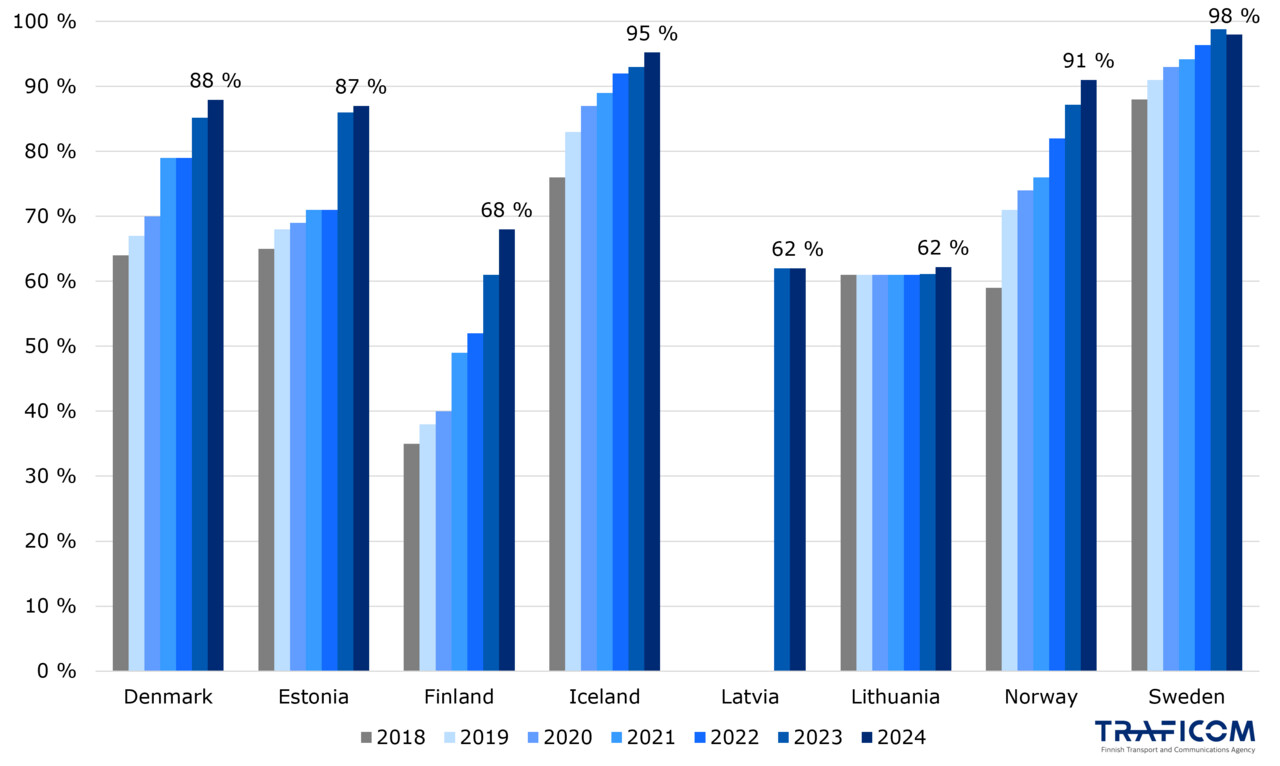In 2024, the availability of fibre connections for households in the Nordic and Baltic countries ranged from 62 to 98 percent. In Finland fibre availability was 68 percent. Finland has long lagged behind the comparison countries, but growth in recent years has been clearly the strongest. In all countries, connections implemented with fibre already account for at least half of all broadband subscriptions in use. The data comes from statistics compiled jointly by the authorities responsible for telecommunications statistics.
The availability of fixed broadband connections implemented with fibre technology has increased in all Nordic and Baltic countries in recent years. In Finland, the increase has been particularly rapid: fibre availability has grown by a total of 30 percentage points from the beginning of the decade to autumn 2024. An increasing number of Finnish households now have access to a fixed broadband connection that supports a wide range of digital services of today and the future.
Growth rates vary between countries
In Denmark, Estonia and Norway, fibre availability has increased by around 20 percentage points during the decade. In Iceland and Sweden, growth has been clearly slower because fibre availability was already at a very high level at the beginning of the decade. As fibre roll-out moves from city centres and densely populated areas to more sparsely populated regions, the pace of growth slows down.

Fibre subscriptions are replacing older technologies
As availability has increased, the number of fibre subscriptions in use has also grown. In some countries, fibre already accounted for a significant share in 2015, while in Finland only about one quarter of active subscriptions were fibre-based at that time.
With new construction and the gradual phase-out of old copper and cable modem networks, the situation has changed rapidly. By the end of 2024, as many as 82 percent of Finland’s fixed broadband subscriptions were fibre connections. Only in Estonia did the share of fibre subscriptions remain below 60 percent.

Adoption rate is rising in Finland
Based on the combined statistics of the Nordic and Baltic countries, it is also possible to calculate the adoption rate of fibre connections. This refers to the percentage of available fibre connections that have been taken into actual internet use. In 2021, 81 percent of the fibre connections available in Finland were in use, and by the end of 2024 the share had risen to 86 percent.
In Sweden, the adoption rate is no longer increasing at the same pace, as many of those who wanted a connection have already obtained one. Not all households need a broadband subscription even if a connection has been built and made available.
Most fixed broadband subscriptions are used in households
When calculating the adoption rate, it is important to note that the number of subscriptions includes both household and business connections, while availability only describes the connections built for households. In all countries except Denmark (87 percent) and Iceland (72 percent), however, more than 90 percent of active subscriptions are household connections, which makes the comparison reliable. It can also be assumed that some business subscriptions correspond to household use, for example when an employer provides a connection or an entrepreneur works from home.
When examining household fibre subscriptions only, 77 percent of the fibre availability in Finland was in use in 2021 and 81 percent in 2024. In Sweden, the corresponding figure was 71 percent in both years.

Enquiries and more information
Each year Traficom, together with the corresponding authorities in the Nordic and Baltic countries, compiles comparable statistics on the region’s telecommunications market. In addition to fibre statistics, the data includes information such as mobile network data volumes, the number of mobile subscriptions, and the revenue and investment levels of the telecommunications sector.
A presentation (External link) describing the statistics is available on Traficom’s website
The Swedish Post and Telecom Authority (PTS) publishes the full statistics (External link) on its website (in Swedish and English)
An article on the comparative statistics published in autumn 2024
Marja Heinonen, Senior Specialist, tel. +358 29 534 7355, Contact form (External link) for statistical data services, marja.heinonen@traficom.fi .fi